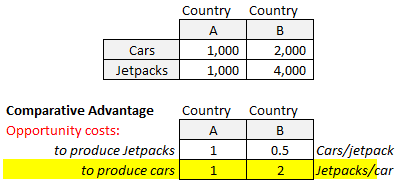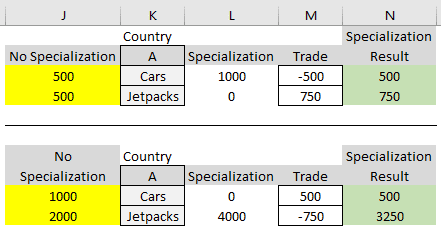MBA students encounter the concepts of specialization, trade, absolute advantage, and comparative advantage in their economics class. It is smooth sailing for MBA students if the economics professor stops after explaining these concepts. However, if questions with numbers get thrown in, students struggle. We know this because many students request economics tutoring on specialization, trade, absolute advantage, and comparative advantage.
Absolute advantage vs. Comparative advantage
Let us first understand the terms absolute advantage and comparative advantage. Using numbers to illustrate the meaning of absolute advantage and comparative advantage helps.
Absolute Advantage
A country/firm/individual is said to have an absolute advantage in producing a good if the cost of producing that good is lower than producing the same good in the other country/firm/individual. For example, in the illustration below:

We can see that on a given day, country B can produce more cars (2,000 vs. 1,000) and more wine (4,000 vs. 1,000) than country A. (assuming all other costs are similar). Therefore, we agree that country B has an absolute advantage over country A in producing cars and wine. We can say this because country B can make more cars and wine than country A in a day.
Does this mean that country B has a comparative advantage over country A in producing cars and/or wine? Will be no trade? Does this mean that country B has no incentive to trade with country A as it is more efficient? Look carefully!
Comparative Advantage
A country/firm/individual is said to have a comparative advantage in producing a good if the cost of producing that good relative to other goods is lower than the cost of producing that good relative to other goods in the other country/firm/individual.
Comparative advantage may be simpler to understand in terms of opportunity cost. The cost of producing that good relative to other goods is measured in the opportunity costs of other goods. A country/firm/individual is said to have a comparative advantage in producing a good if the opportunity cost of producing that good is lower than the opportunity cost of producing the same good in the other country/firm/individual. For example:
Note that we can understand this in terms of efficiency. Units can be measured as a per unit of labor required or output per unit of time.

Opportunity Cost
Opportunity cost is the value of what we give up to gain something. Let us, as an example, look at the opportunity cost to produce cars (second row) in the above situation. Country A gives up 1 unit of Jetpacks to produce 1 unit of cars. So we say the opportunity cost to produce one car is one jet pack or a ratio of 1:1 for country A. However, Country B gives up two units of Jetpacks to produce 1 unit of cars. So we say the opportunity cost to produce one car is two jet packs or a ratio of 1:2 for country B.
This opportunity cost ratio can be inversed or scaled up or down. For example, this 1:2 ratio can be inversed to say the opportunity cost to produce one jet pack is 0.5 cars or a ratio of 1:0.5 for country B. This ratio of 1:2 ratio can be scaled up to 100:200 or scaled down to 0.5:1.
Allocation of Resources – Comparative Advantage, Specialization & Trade
When we want to allocate resources, we must factor in the comparative advantage we hold. Once you know your comparative advantage, you assign your scarce resource to the product that you have the lowest opportunity cost. This is because you can trade to make up what you need for the other products.
Specialization
Allocating resources to produce more of one good is called specialization. To improve utility or increase value or GDP, we must specialize in producing more of what has a lower opportunity cost. This specialization often leads to more efficiency and therefore increasing comparative advantage. This is a reinforcing cycle.
Gains from Trade
We have seen above that countries/individuals/firms must allocate their resources to products with the lowest opportunity costs. This also means that they will specialize. And this means that they will produce more of one good and less of the other good. This works ok because they will be better off when they specialize and trade.

For example, in the illustration above, we can see that country A has a lower opportunity cost of producing cars (gives up only 1 unit of wine as opposed to 2 units of wine for country B). So A specializes in cars and produces only cars (1000 units), and B specializes in jetpacks and produces only jetpacks (4000 units) (column L).
Now, if country A offers to trade 500 cars to country B in exchange for 750 Jetpacks, will country B accept the offer? Will they be better off? (look at column N) Compare it to where they would be if both countries produced cars and jetpacks (column J).
You must notice that neither A nor B is forced into specializing or trading in a free world. Both A and B will be motivated by self-interest to trade because both A and B are better off specializing in producing their strengths and trading! Country A has the same number of cars and more jetpacks than if A produced both. And country B has had to give up only 750 jetpacks instead of 1000 to get 500 cars. This is why the net result is said to be positive in a free market.
Production Possibilities Curve
In understanding the concepts of specialization, trade, absolute advantage and comparative advantage in their economics class, it is helpful to view the relationships in terms of the Production Possibilities Curve.
The production possibilities curve depicts the quantity of two products that can be produced given a specified amount of resources. Production possibilities curves are also called production possibility frontiers, transformation curves, or tradeoff diagrams.
We have the following points or areas to keep in mind in the production possibility curve.
- Attainable point/area is a combination of goods that can be produced using current resources given the present production tradeoffs.
- An unattainable point/area is the combination of goods that cannot be produced using current resources given the present production tradeoffs.
- Efficient point/area is usually on the frontier and shows the combinations of goods whose production cannot be increased without increasing current resources.
- An inefficient point/area is a location/combination of goods that can be produced, leaving extra capacity of current resources.
If we can help you understand any aspect of absolute advantage, comparative advantage, specialization, or trade-related to economics, please do let us know.